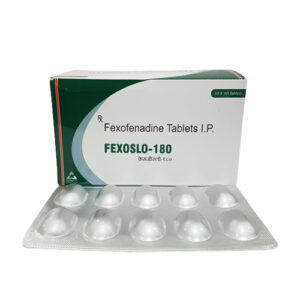No products in the basket.

As the seasons change, many people find themselves reaching for antihistamines to combat the pesky symptoms of hay fever. One of the most commonly prescribed medications for this condition is fexofenadine. This blog aims to provide an in-depth understanding of fexofenadine, how it works, its uses for hay fever, and important considerations for its use.
People widely use fexofenadine, a second-generation antihistamine, to relieve allergy symptoms. Unlike first-generation antihistamines, such as diphenhydramine, fexofenadine is less likely to cause drowsiness. It works by blocking the action of histamine, a substance in the body that causes allergic symptoms when released.

When allergens such as pollen, dust, or pet dander enter the body, the immune system reacts by releasing histamine. This release can lead to symptoms like sneezing, itching, runny nose, and watery eyes—common indicators of hay fever. Fexofenadine works by antagonising the H1 receptor, which means it prevents histamine from binding to its receptors, thereby reducing the symptoms associated with allergic reactions.
Mostly, doctors prescribe fexofenadine to treat allergic rhinitis, also known as hay fever. The following are some of the key symptoms it helps manage:
Fexofenadine can provide relief from these symptoms for both seasonal allergies (like those caused by pollen) and perennial allergies (like those caused by dust mites and pet dander).
Fexofenadine is available in various forms, including tablets, liquid suspensions, and orally disintegrating tablets. The typical adult dosage is 60 mg taken twice daily or 180 mg once daily, depending on the severity of symptoms and the specific product formulation. It’s essential to follow the dosage instructions provided by a healthcare professional or those indicated on the packaging.
While fexofenadine is generally well-tolerated, it’s important to keep the following in mind:
Fexofenadine is an effective and convenient option for managing the symptoms of hay fever, allowing individuals to enjoy their daily activities without the discomfort of allergies. If you’re considering using fexofenadine, consult with a healthcare provider to ensure it’s the right choice for your specific situation. With the right approach, you can control your allergy symptoms and enjoy the beauty of each season without hindrance.
If you find yourself struggling with hay fever, consider speaking to your healthcare provider about fexofenadine and other available treatment options. With the right management plan, you can minimise the impact of allergies on your life and enjoy the great outdoors again!